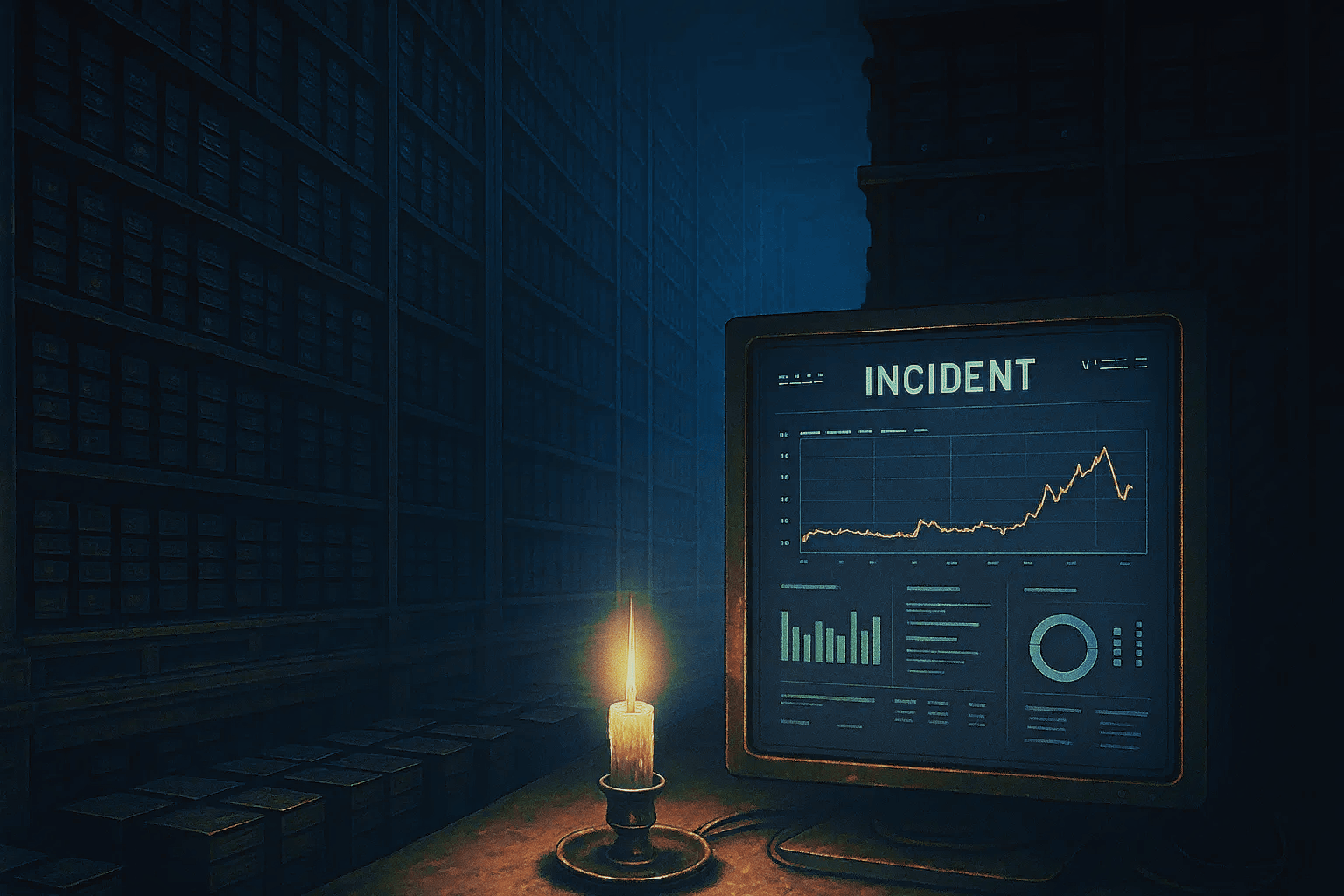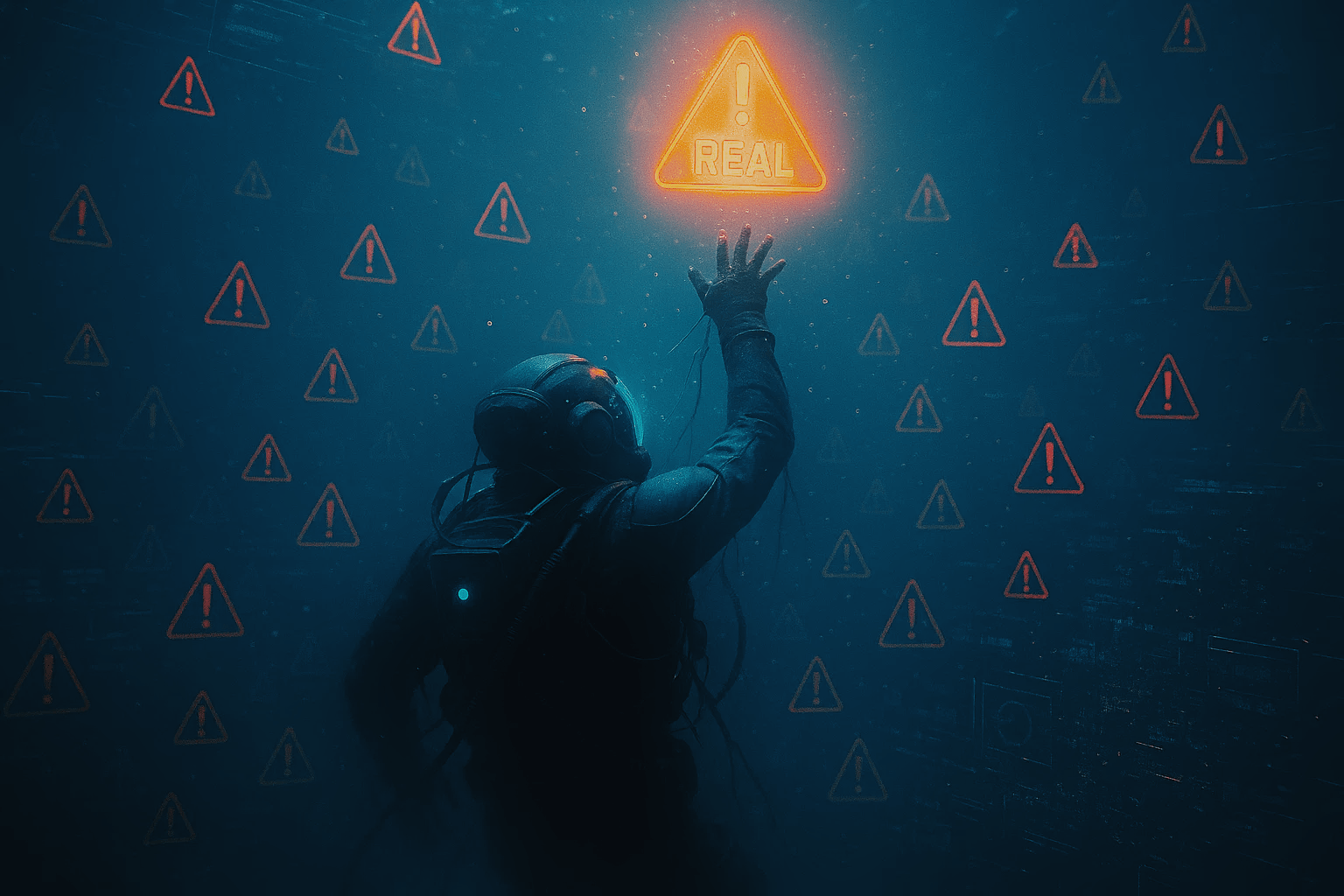How the Quest for Infinite Data Eclipsed Real-Time Comprehension
Introduction
The discipline of managing complex, large-scale software systems is currently in a state of paradox. Over the past decade, the industry has undergone a significant shift, moving away from the perceived limitations of traditional monitoring towards the expansive promise of observability.
This transition wasn’t merely a technological upgrade but a fundamental change in philosophy, driven by the undeniable explosion in system complexity brought about by microservices, cloud-native architectures, and ephemeral infrastructure.
The new paradigm, centered around the “three pillars” of metrics, logs, and traces, presented a compelling proposition: the ability to inquire about a system’s past behavior to debug novel and unpredictable failures—the so-called “unknown unknowns.” Vendors and thought leaders alike hailed this as the evolution of monitoring, the essential toolkit for the modern era of software.
However, this post argues that the industry’s shift towards observability, while addressing critical issues in forensic analysis, has inadvertently created a dangerous operational blind spot.
In the relentless pursuit of collecting sufficient data to comprehend all that has transpired, the discipline has systematically devalued and undermined the tools and practices essential for understanding the present moment. The very function responsible for real-time situational awareness—monitoring—wasn’t designed to address contemporary challenges but was instead subsumed and effectively abandoned, resulting in a critical capability gap.
The repercussions of this overcorrection are now evident across the industry, manifesting as unsustainable costs, overwhelming data, pervasive alert fatigue, and incident response workflows that treat live outages as archaeological digs. Operators, overwhelmed by a sea of low-signal data and confronted with dashboards that offer correlation without comprehension, are increasingly compelled to bypass their real-time tools entirely. Instead, they jump straight into deep, forensic investigations while systems are still actively failing.
The promise of comprehensive understanding has led to a reality where we struggle to comprehend the present. The objective here isn’t to reject the power of observability, but to restore a necessary balance, re-establishing monitoring as the distinct and foundational discipline of operational readiness.

The Unfinished Evolution of Monitoring
Traditional monitoring wasn’t a solved problem that reached its natural endpoint; it was an underdeveloped practice whose foundational assumptions were shattered by a new era of architectural complexity.
Confronted with this paradigm shift, the industry didn’t undertake the difficult work of evolving the principles of real-time monitoring. Instead, driven by new technical challenges and powerful vendor narratives, it pivoted to a different problem entirely, leaving the crucial capability of real-time comprehension in a state of arrested development.
The industry’s response to the complexity crisis wasn’t to fundamentally redesign monitoring for a dynamic world, but to adopt a new paradigm altogether. This new approach, labelled observability, a term borrowed from control theory, aimed to be more than a technological upgrade; it was a fundamental shift in perspective.
Observability proposed transitioning from a deterministic model, where critical failure signals could be predetermined, to a probabilistic one. The new assumption was that in a complex system, it’s impossible to anticipate what’ll be significant. Consequently, the primary objective should be to collect sufficient raw, high-fidelity data from the system’s outputs—logs, metrics, and traces—so that any inquiry about its internal state could be posed and answered after a failure had occurred.
This narrative gained significant traction with the emergence of a niche vendors who developed platforms specifically designed to facilitate this exploratory, post-hoc workflow. These vendors positioned observability as the “evolution” of monitoring, presenting it as the essential successor for the cloud-native era.
Consequently, there was a compelling commercial incentive to sell entirely new platforms instead of investing in the challenging and less glamorous task of refining existing monitoring principles. In this new hierarchy, monitoring was relegated to a subordinate position. It was now portrayed as merely a subset of observability—a straightforward data collection function that provides the “when” and “what” of an error, but which falls short without observability to offer the crucial “why” and “how”.
This significant shift in focus resulted in the neglect of the core discipline of real-time state comprehension. Instead of addressing the challenge of building monitoring systems that offer a high-signal, real-time view of dynamic and complex systems, the industry shifted its attention to collecting sufficient historical data for debugging potential failures. This shift diverted the focus from present-day comprehension to past investigation.
While the evolution of monitoring wasn’t yet complete, it was abandoned in favor of a different pursuit, leaving a critical gap in the operational toolkit that persists to this day. Observability wasn’t an evolution of monitoring, but a rebranding of its abdication.

The Primacy of the Past
The shift toward observability emerged as a response to the limitations of traditional monitoring. It empowered engineers to investigate the novel, intricate failures that define modern distributed systems.
Yet this shift has become an overcorrection. In prioritizing comprehensive, retrospective forensic analysis, the observability paradigm was architected around principles that inherently favor the past over the present. Its emphasis on constructing a perfect historical record has introduced a new class of systemic issues—data deluge, escalating costs, and cognitive fatigue—that now undermine an organization’s ability to maintain real-time operational awareness and effectiveness.
At the heart of the observability paradigm lies a foundational principle: the capability to pose questions about the system after an event has occurred. This retrospective flexibility comes with a significant architectural cost—namely, the need for comprehensive, continuous data collection and long-term retention.
To ensure that any unforeseen question can be answered in the future, observability platforms are incentivized to ingest and store vast volumes of raw, high-fidelity telemetry. This “collect everything” ethos, widely promoted by vendors and adopted by practitioners, has led to a deluge of data—one that carries both explicit and hidden costs.
The most immediate consequence is financial. The ingestion, processing, and storage of terabytes or even petabytes of telemetry imposes extraordinary expenses. These costs were once obscured by a venture-fueled, low-interest economic climate, in which aggressive spending on infrastructure was tolerated, even encouraged. Today, as fiscal scrutiny increases, organizations are confronting the hard economic realities of observability at scale—and questioning the value of retaining mountains of data that often yield little actionable insight.
Less visible—but arguably more insidious—is the cognitive burden imposed by this data excess. During an incident, engineers are confronted not with clarity but with a needle-in-a-haystack dilemma. The flood of noisy and often irrelevant telemetry overwhelms responders, increasing cognitive load at the exact moment focus and speed are critical. The well-intentioned effort to provide more data has paradoxically resulted in less comprehension. Instead of guiding operators to insight, the system buries them in volume, contributing to delayed diagnosis, poor decision-making, and eventually burnout.
This explosion of data also introduces a severe and compounding technical consequence: the high-cardinality crisis. Cardinality—the number of unique values within a dataset dimension—can quickly spiral out of control in complex, dynamic systems. Time-series databases, already under pressure from massive ingestion volumes, struggle to handle high-cardinality datasets, resulting in ballooning storage costs, degraded query performance, and in extreme cases, complete platform collapse. This failure often occurs precisely when observability is most needed: during a live incident.
The architectural requirements for effective forensic analysis stand in fundamental opposition to those needed for real-time comprehension. A forensic system thrives on the ingestion of raw, high-cardinality data and the availability of a flexible, powerful query engine to enable exploratory, post-hoc investigation. In contrast, a system designed for real-time awareness requires the opposite: aggressive filtering, on-the-fly aggregation, and context-aware transformation—producing a curated, low-dimensional, high-signal representation of system health that can be understood instantly.
Attempting to satisfy both use cases with a single architectural model has led the industry into a costly trap. The “collect everything” approach—well-suited for retrospective debugging—has become the default substrate for all operational functions. As a result, dashboards and alerts, which are intended to support real-time decisions, are forced to query the same bloated, latency-prone, high-cardinality datastore. This mismatch in design intent creates systemic drag: tools optimized for the past are now being misused to navigate the present. The very architecture that promised insight is now the source of delay and distortion.

The Vendor Narrative
This architectural compromise has been further entrenched by a dominant vendor narrative. Modern observability platforms are marketed as “unified” solutions—promising seamless integration of metrics, logs, and traces under a single pane of glass. These platforms are consistently framed as the natural evolution or superset of monitoring, a framing that deliberately obscures the functional and epistemological distinctions between observability and real-time awareness.
This marketing strategy makes a critical conflation: it equates the ability to conduct deep forensic analysis with the ability to sustain real-time situational comprehension. The powerful querying, debugging, and distributed tracing features—rightly celebrated for post-incident investigation—are positioned as the primary tools for all operational workflows. As a result, customers are guided toward an architecture that emphasizes exhaustive data capture and retrospective tooling, even for tasks that demand immediate responsiveness.
This emphasis de-prioritizes real-time interfaces. Dashboards and alerting consoles—tools that should provide fast, focused insight into the current state—are relegated to lightweight visualization layers sitting atop forensic backends. They inherit the same limitations: sluggish performance, high signal-to-noise ratios, and delayed clarity. The unified narrative promises a single tool for both foresight and hindsight, but the implementation delivers a system optimized for the latter—at the cost of the former.
A Present Unobserved
The industry’s overcorrection toward a forensic-first model of observability has come at a steep cost. It has created a critical operational blind spot, undermining the very capability it was meant to enhance: the ability of human operators to perceive and respond to system failures in real time. The tools designed to provide clarity have instead generated overwhelming volumes of noise and complexity.
This shift has produced a systemic breakdown in the human-computer interface of operations. Dashboards—once central to situational awareness—have declined into passive data visualizations, overloaded and unreadable under pressure. Alert fatigue has become normalized, dulling operator responsiveness and eroding trust in signals. Most tellingly, incident response workflows now routinely bypass real-time observability tools altogether. Instead, responders jump straight into post-mortem forensics while the incident is still in progress—a pattern that reveals not just tool failure, but a collapse of confidence in the present-tense capabilities of the entire observability stack.
The Death of the Dashboard
In a previous era of operations, the dashboard served as the nerve center—a true “single pane of glass” that offered at-a-glance situational awareness across the system. It was the operator’s cockpit, designed for clarity, immediacy, and decision-making under pressure. Today, that function has been fundamentally eroded. In many organizations, the modern observability dashboard has devolved into a cluttered, disjointed data graveyard—an overgrown surface of charts, panels, and metrics that overwhelm rather than inform. What was once a tool for operational focus has become a monument to telemetry, where signal is buried beneath noise and comprehension gives way to cognitive fatigue.
Several factors have contributed to the dashboard’s decline. Chief among them is information overload. In an effort to visualize the vast telemetry harvested by observability platforms, dashboards are often packed with dozens of charts and time series—far exceeding the five to nine visual elements that cognitive research suggests the human brain can meaningfully process at once. Confronted with this visual onslaught, operators tend to scan for the most obvious anomalies, while subtle but critical patterns go unnoticed.
A second issue is lack of actionable context. Dashboards frequently present raw metrics without interpretation. Without temporal baselines, workload context, or downstream impact, such a reading offers no operational insight. It tells us what happened, but not whether it matters. In the absence of embedded guidance or decision cues, the dashboard becomes a passive reporting interface rather than an active decision-support system. As a result, most dashboards have settled into the role of maintenance confirmation tools—useful for verifying that nothing appears catastrophically broken, but rarely capable of revealing how the system is behaving or why a deviation is significant. The dashboard has been reduced to a sensor check, not a situational console.

Alert Fatigue as a Systemic Failure
Alert fatigue is often misconstrued as a cultural or procedural issue—something to be solved through better documentation, refined runbooks, or improved team discipline. In truth, it reflects a deeper, systemic flaw in the underlying technology. The problem arises when on-call teams are bombarded with a relentless stream of low-value alerts: false positives, redundant warnings, and notifications lacking clear context or actionable guidance. Over time, this constant barrage dulls operator sensitivity, leading to desensitization, delayed reactions, and diminished trust in the alerting system itself.
This isn’t a minor inconvenience—it’s a critical operational vulnerability. When operators stop trusting alerts, genuine signals of failure are buried in noise. The result is a heightened risk of prolonged outages, cascading system failures, and confusion during incident response. A system that can’t distinguish urgency from background telemetry has failed its most basic obligation: to direct human attention precisely when and where it matters most.
The human toll is equally severe. The stress of being repeatedly interrupted—often in the middle of the night—by meaningless pages erodes sleep, focus, and morale. Over time, this leads to psychological fatigue, burnout, and attrition. Ironically, the very systems built to ensure resilience and continuity have become a primary source of disruption and distress for the engineers tasked with maintaining them.
The most damning evidence of monitoring’s decline lies in the behavior of operators during a live incident. Confronted with untrustworthy alerts and incomprehensible dashboards, the first instinct of a seasoned engineer is often not to consult the monitoring UI, but to bypass it entirely—opening a terminal to begin querying raw logs or traces from first principles. This shift in behavior reflects a deep loss of faith in the system’s capacity to provide real-time situational comprehension.
In these moments, the incident is no longer treated as a live event to be understood, navigated, and resolved through a trusted awareness surface. Instead, it becomes a crime scene, already broken, already lost—an object of forensic investigation rather than operational control. What should be an interface for sense-making and action has been reduced to a passive archive, incapable of supporting the immediacy and confidence that effective incident response demands.
This systemic failure can be understood as a collapse of the OODA loop—the cognitive cycle of Observe, Orient, Decide, and Act that underpins effective decision-making in high-pressure environments. The breakdown begins at the very first step. The “Observe” phase is compromised by alert fatigue: a deluge of untrustworthy, low-signal notifications erodes the operator’s ability to detect meaningful events. The “Orient” phase then fails under the weight of cluttered, context-poor dashboards, which prevent the formation of a coherent mental model of the system’s state. Without reliable observation or orientation, the operator cannot confidently “Decide” on a course of action.
What follows isn’t action, but abandonment. The operator is forced to exit the real-time OODA loop entirely, resorting instead to a slower, forensic investigation cycle—querying logs, reconstructing timelines, and interpreting raw traces from first principles. This leapfrogging of the real-time interface replaces a potentially sub-second feedback loop with a process that takes minutes or hours, dramatically inflating Mean Time to Resolution (MTTR). More critically, it reveals a catastrophic failure of the tooling to fulfill its core purpose: to accelerate accurate, confident decisions under pressure.

A Renaissance for Monitoring
The critique of today’s operational awareness landscape isn’t a plea to return to the brittle dashboards and threshold alerts of the past. It’s a call to action—a demand to reestablish monitoring as a distinct, first-class engineering discipline, one that is purpose-built for real-time comprehension in complex, dynamic systems.
This renaissance begins with a shift in focus: away from indiscriminate data collection and toward intelligent signal processing. It calls for leveraging modern capabilities—such as machine learning—not to analyze after the fact, but to build adaptive, context-aware systems that can distill meaning in the moment. It means enriching telemetry with operational semantics, so data becomes actionable insight. And it requires a fundamental redesign of user interfaces, guided by principles of cognitive ergonomics, to support fast, confident decision-making under pressure.
The future of monitoring isn’t retrograde—it is reforged, with clarity, intent, and human-centered design at its core.
To rebuild monitoring as a discipline of real-time awareness, we must design systems that prioritize perceptual alignment over raw access. This means ensuring that the system presents the operator with the most relevant information at the moment. This requires more than simply adding new features; it demands a fundamental shift in both the architectural and philosophical approaches to monitoring.
The next generation of monitoring systems won’t be built on raw access to telemetry, but on the capacity to make meaning from change. In place of indiscriminate data collection, we need architectures that sense, interpret, and respond in context. Monitoring must evolve from a telemetry exhaust pipe into a coherent semantic layer—a live system of signals and understanding that operates in alignment with human cognition and operational significance.
This shift begins by moving away from raw data streams and toward purposeful signals. Signals shouldn’t simply report activity, but encode transitions, anomalies, or shifts in state that are meaningful to the system’s operation. These must be emitted with clarity and intent—not as noise, but as signs that something in the system demands attention. Rather than drowning in charts and counters, operators must be presented with a flow of interpreted cues, organized by relevance, priority, and context.
To achieve this, telemetry must be contextually enriched at the point of generation or interception. System signals should carry not just numerical values, but embedded relationships—temporal expectations, historical baselines, service dependencies, and risk implications. Meaning arises not from the signal alone, but from its orientation within a network of expectations. In this way, we move from monitoring as measurement to monitoring as sense-making.
But meaning isn’t static. Modern infrastructures are dynamic, and so must be the mechanisms through which signals are filtered and prioritized. Systems must learn over time which signals carry value and which don’t—adapting not only to the system’s changing behavior, but to the operators’ evolving perception of what matters. This calls for adaptive filtration and interpretation, tuned not by static thresholds but by ongoing feedback from operational experience.
At the interface level, this requires more than just visual polish. The dashboard’s role isn’t to present everything, but to facilitate understanding. Interfaces must be designed for immediacy and clarity, considering how humans scan, assess, and make decisions under pressure. They should minimize noise, not replicate it. Visual surfaces shouldn’t merely display data but reveal conditions, shifts, and courses of action—transforming monitoring from passive observation into active engagement.
In the end, monitoring must evolve into a layer of operational awareness—a foundation not just for observing systems, but for actively engaging with them through meaningful signs. It’s not about seeing everything; it’s about perceiving what truly matters, when it truly matters, in a format that facilitates action. This isn’t a return to outdated tools; it’s the emergence of a novel architecture of attention, specifically designed for systems that are dynamic, adaptable, and capable of thinking.
The path out of the observability paradox starts with a fundamental shift in our conceptual models. The prevailing narrative, which frames observability as a linear progression of monitoring, is both simplistic and inaccurate. Observability isn’t a single, sequential stage in a linear trajectory, but rather a set of distinct and symbiotic disciplines, each with its own purpose, architectural requirements, and operational workflows.
Monitoring isn’t obsolete; it’s fundamental. It provides the real-time situational awareness necessary to maintain system control under pressure. Observability, on the other hand, serves as a forensic lens, crucial for post-hoc analysis and comprehending novel failure modes. Resilient operations necessitate both—but they must be comprehended, designed, and deployed on their own terms.
To restore operational readiness, we must reclaim the primacy of real-time comprehension—not as a legacy artifact, but as the cognitive core of modern system stewardship.
Appendix: Commentary
Cybernetics and System Feedback Loops
Cybernetics, at its core, is concerned with the regulation and control of systems through feedback loops. In the context of observability, the shift towards historical analysis has disrupted the ability to maintain real-time system control. In complex, dynamic environments, immediate feedback is essential to stabilize the system. When systems are designed to collect vast amounts of data for post-mortem analysis, they neglect the need for real-time corrective action.
Organizational Theory: Operational Readiness and Workflow Alignment
In organizational theory, workflow alignment refers to the matching of system capabilities with the needs of the organization. The critique here is that the industry has shifted its focus from operational readiness (immediate comprehension) to a forensic-first approach (past behavior analysis), creating a disconnect between system operations and organizational decision-making. This misalignment leads to inefficiencies where teams are overwhelmed by data overload rather than empowered by actionable insights.
Human-Computer Interaction (HCI): Rebuilding Interfaces for Cognitive Engagement
The concept of human-computer interaction (HCI) in observability is critical in understanding how operators interact with systems. The transition from monitoring to observability has introduced significant cognitive overload, where operators face an overwhelming amount of information that impedes effective decision-making.
Situational Awareness: From Retrospective to Real-Time Perception
Situational awareness (SA) theory suggests that understanding the present state of a system is key to effective decision-making. Observability’s emphasis on historical analysis neglects the critical need for real-time understanding of system performance. This has led to a situation where systems are increasingly blind to current conditions and reliant on forensic investigation after failures occur.
Semiotics: Making Signals Meaningful in Complex Systems
The explosion of data in modern observability systems has introduced a semiotic challenge: an overwhelming abundance of signals with little actionable meaning. Semiotics, the study of signs and symbols, teaches that the meaning of a signal is derived from its context and relation to other signs. Current observability systems fail to provide adequate sense-making context for understanding the significance of raw data.
FinOps and Cost Considerations: Balancing Data Collection with Operational Efficiency
In observability, FinOps highlights the financial impact of collecting and storing vast amounts of telemetry data. Observability platforms capture all relevant data, assuming future forensic utility. However, the costs of ingesting, storing, and processing this data become unsustainable. As organizations face budget constraints and financial accountability demands, they must evaluate the value of storing terabytes of raw telemetry data if it offers limited real-time insights.
